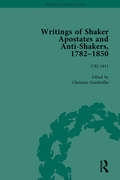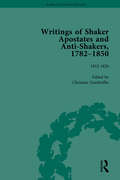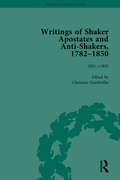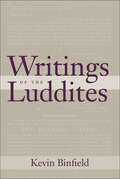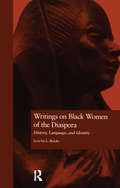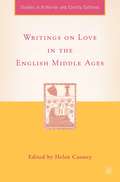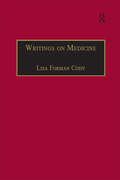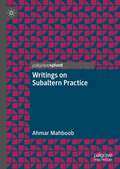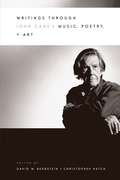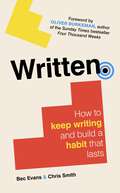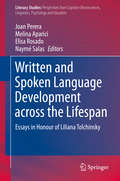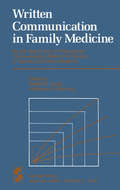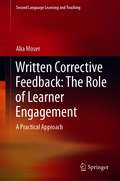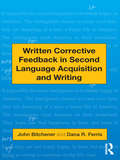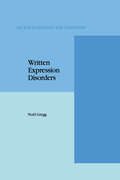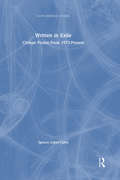- Table View
- List View
Writings of Shaker Apostates and Anti-Shakers, 1782-1850 Vol 1 (American Communal Societies Ser.)
by Christian GoodwillieThe Shakers are perhaps the best known of American religious communities. Their ethos and organization had a practical influence on many other communities and on society as a whole. This three volume collection presents writings from a broad cross-section of those who opposed the Shakers and their way of life.
Writings of Shaker Apostates and Anti-Shakers, 1782-1850 Vol 2 (American Communal Societies Ser.)
by Christian GoodwillieThe Shakers are perhaps the best known of American religious communities. Their ethos and organization had a practical influence on many other communities and on society as a whole. This three volume collection presents writings from a broad cross-section of those who opposed the Shakers and their way of life.
Writings of Shaker Apostates and Anti-Shakers, 1782-1850 Vol 2
by Christian GoodwillieThe Shakers are perhaps the best known of American religious communities. Their ethos and organization had a practical influence on many other communities and on society as a whole. This three volume collection presents writings from a broad cross-section of those who opposed the Shakers and their way of life.
Writings of Shaker Apostates and Anti-Shakers, 1782-1850 Vol 3
by Christian GoodwillieThe Shakers are perhaps the best known of American religious communities. Their ethos and organization had a practical influence on many other communities and on society as a whole. This three volume collection presents writings from a broad cross-section of those who opposed the Shakers and their way of life.
Writings of Shaker Apostates and Anti-Shakers, 1782-1850 Vol 3
by Christian GoodwillieThe Shakers are perhaps the best known of American religious communities. Their ethos and organization had a practical influence on many other communities and on society as a whole. This three volume collection presents writings from a broad cross-section of those who opposed the Shakers and their way of life.
Writings of the Luddites
by Kevin BinfieldNamed for their probably mythical leader, Ned Ludd, the Luddites were a group of social agitators in nineteenth-century Britain who tried to prevent the mechanization of cloth factories, which they blamed for increased unemployment, poverty, and hunger in industrial centers. Though famous for their often violent protests, the Luddites also engaged in literary resistance in the form of poems, proclamations, petitions, songs, and letters. In Writings of the Luddites, Kevin Binfield collects complete texts written by Luddites or Luddite sympathizers between 1811 and 1816, adds detailed notes, and organizes the documents by the three primary regions of origin: the Midlands, Northwestern England, and Yorkshire. Binfield’s extensive introduction provides a historical overview of the Luddites and their activities, explores their rhetorical strategies, and illuminates their literary context. Written for the most part from a collective point of view, the texts themselves range from judicious to bloodthirsty in tone and reveal a fascination both with legal forms of address and with the more personal forms of Romantic literature, as well as with the recent political revolutions in France and America.
Writings of the Luddites
by Kevin BinfieldNamed for their probably mythical leader, Ned Ludd, the Luddites were a group of social agitators in nineteenth-century Britain who tried to prevent the mechanization of cloth factories, which they blamed for increased unemployment, poverty, and hunger in industrial centers. Though famous for their often violent protests, the Luddites also engaged in literary resistance in the form of poems, proclamations, petitions, songs, and letters. In Writings of the Luddites, Kevin Binfield collects complete texts written by Luddites or Luddite sympathizers between 1811 and 1816, adds detailed notes, and organizes the documents by the three primary regions of origin: the Midlands, Northwestern England, and Yorkshire. Binfield’s extensive introduction provides a historical overview of the Luddites and their activities, explores their rhetorical strategies, and illuminates their literary context. Written for the most part from a collective point of view, the texts themselves range from judicious to bloodthirsty in tone and reveal a fascination both with legal forms of address and with the more personal forms of Romantic literature, as well as with the recent political revolutions in France and America.
Writings on Black Women of the Diaspora: History, Language, and Identity (Crosscurrents in African American History #1)
by Lean'tin BracksToni Morrison, Alice Walker, Paule Marshall, and Mary Prince represent the best of African American women writers who draw on the tortuous legacy of their people as a source for their art, revealing and defining themselves as they create compelling narratives that illuminate their roots, their heritage, and their unique culture. The themes that suffuse their writing are family, community, strong women, cultural memory, oral history, and slavery. By analyzing the works of these four remarkable writers, the study shows how today's black woman can take control of her destiny by coming to grips with an obscured and distorted past. These original essays articulate the way in which historical awareness, sensitivity to language, and an understanding of stereotypes can empower enduring artistic visions in a world that is largely indifferent to marginal voices.
Writings on Black Women of the Diaspora: History, Language, and Identity (Crosscurrents in African American History #1)
by Lean'tin BracksToni Morrison, Alice Walker, Paule Marshall, and Mary Prince represent the best of African American women writers who draw on the tortuous legacy of their people as a source for their art, revealing and defining themselves as they create compelling narratives that illuminate their roots, their heritage, and their unique culture. The themes that suffuse their writing are family, community, strong women, cultural memory, oral history, and slavery. By analyzing the works of these four remarkable writers, the study shows how today's black woman can take control of her destiny by coming to grips with an obscured and distorted past. These original essays articulate the way in which historical awareness, sensitivity to language, and an understanding of stereotypes can empower enduring artistic visions in a world that is largely indifferent to marginal voices.
Writings on Love in the English Middle Ages (Arthurian and Courtly Cultures)
by H. CooneyThis is a set of essays from many of the leading scholars in the world of medieval studies, which addresses a wide diversity of texts and genres and their diverse perspectives on love. Attention is given to interaction between English writings and putative continental and international influences, with particular emphasis on the works of Chaucer.
Writings on Medicine: Printed Writings 1641–1700: Series II, Part One, Volume 4 (The Early Modern Englishwoman: A Facsimile Library of Essential Works & Printed Writings, 1641-1700: Series II, Part One)
by Lisa Forman CodyThe four works in this volume are the only known exclusively medical texts written by women during the Restoration. Their importance is denoted by their dramatic challenge to the generalisations once made about medical practice and female healers in this period. Jane Sharp's The Midwives Book was the first and only midwifery manual to be printed in English before 1700, and continued to be influential into the early eighteenth century. The principal focus of Elizabeth Cellier's To Dr.--- (1688) is the attempt to legitimate the notion of a female corporation of midwives through historical precedent. To Dr.--- was in fact borne out of a previously unpublished effort, 'A Scheme for the Foundation of a Royal Hospital', sent to James II in 1687. In the document, Cellier outlined a specific scheme for training female midwives and supporting poor, pregnant women and abandoned children. Mary Trye began practising 'chymical physic' at her father's side in London in 1663. Her only known work, Medicatrix, was published in 1675. Trye claimed female medical authorship to be unique, in that women observed nature truly and administered genuine medical solutions to the sick. The writings of Sharp, Cellier and Trye have helped to overturn historians' assumptions about a woman's role in medicine and healing. These texts reveal their female authors to be as learned in the humanities and sciences as they were in medical matters.
Writings on Medicine: Printed Writings 1641–1700: Series II, Part One, Volume 4 (The Early Modern Englishwoman: A Facsimile Library of Essential Works & Printed Writings, 1641-1700: Series II, Part One)
by Lisa Forman CodyThe four works in this volume are the only known exclusively medical texts written by women during the Restoration. Their importance is denoted by their dramatic challenge to the generalisations once made about medical practice and female healers in this period. Jane Sharp's The Midwives Book was the first and only midwifery manual to be printed in English before 1700, and continued to be influential into the early eighteenth century. The principal focus of Elizabeth Cellier's To Dr.--- (1688) is the attempt to legitimate the notion of a female corporation of midwives through historical precedent. To Dr.--- was in fact borne out of a previously unpublished effort, 'A Scheme for the Foundation of a Royal Hospital', sent to James II in 1687. In the document, Cellier outlined a specific scheme for training female midwives and supporting poor, pregnant women and abandoned children. Mary Trye began practising 'chymical physic' at her father's side in London in 1663. Her only known work, Medicatrix, was published in 1675. Trye claimed female medical authorship to be unique, in that women observed nature truly and administered genuine medical solutions to the sick. The writings of Sharp, Cellier and Trye have helped to overturn historians' assumptions about a woman's role in medicine and healing. These texts reveal their female authors to be as learned in the humanities and sciences as they were in medical matters.
Writings on Subaltern Practice
by Ahmar MahboobSubaltern theory emerged as a small voice within academia decades ago. Over time, this work generated significant debate and numerous publications, talks, and conferences. However, little has changed in the experienced lives of the masses. This led people to wonder: “the subalterns seem to have a voice, but can they take action?”; or, in other words, is there subaltern practice?This collection of essays and poems, written with a broad audience in mind, hopes to demonstrate not just how the subaltern can identify and question hegemonic practices, but how they can create alternative frameworks and material that enable themselves and their communities. In doing so, this book aims to demonstrate not just how deep the colonial poisons run, but also how to detoxify ourselves and the environment around us.The writings included in this book study the inequalities that we experience in and around us and suggest actions and practices that can help us regain harmony. It is a call for action and a sharing of ideas that can enable us to regain balance and fulfil our human responsibilities.
Writings through John Cage's Music, Poetry, and Art
by David W. Bernstein Christopher HatchThis volume looks at the creative work of the great avant-gardist John Cage from an exciting interdisciplinary perspective, exploring his activities as a composer, performer, thinker, and artist. The essays in this collection grew out of a pivotal gathering during which a spectrum of participants including composers, music scholars, and visual artists, literary critics, poets, and filmmakers convened to examine Cage's extraordinary artistic legacy. Beginning with David Bernstein's introductory essay on the reception of Cage's music, the volume addresses topics ranging from Cage's reluctance to discuss his homosexuality, to his work as a performer and musician, and his forward-looking, provocative experimentation with electronic and other media. Several of the essays draw upon previously unseen sketches and other source materials. Also included are transcripts of lively panel discussions among some of Cage's former colleagues. Taken together, this collection is a much-needed contribution to the study of one of the most significant American artists of the twentieth century.
Writings through John Cage's Music, Poetry, and Art
by David W. Bernstein Christopher HatchThis volume looks at the creative work of the great avant-gardist John Cage from an exciting interdisciplinary perspective, exploring his activities as a composer, performer, thinker, and artist. The essays in this collection grew out of a pivotal gathering during which a spectrum of participants including composers, music scholars, and visual artists, literary critics, poets, and filmmakers convened to examine Cage's extraordinary artistic legacy. Beginning with David Bernstein's introductory essay on the reception of Cage's music, the volume addresses topics ranging from Cage's reluctance to discuss his homosexuality, to his work as a performer and musician, and his forward-looking, provocative experimentation with electronic and other media. Several of the essays draw upon previously unseen sketches and other source materials. Also included are transcripts of lively panel discussions among some of Cage's former colleagues. Taken together, this collection is a much-needed contribution to the study of one of the most significant American artists of the twentieth century.
Writings through John Cage's Music, Poetry, and Art (Phoenix Fiction Ser.)
by David W. Bernstein Christopher HatchThis volume looks at the creative work of the great avant-gardist John Cage from an exciting interdisciplinary perspective, exploring his activities as a composer, performer, thinker, and artist. The essays in this collection grew out of a pivotal gathering during which a spectrum of participants including composers, music scholars, and visual artists, literary critics, poets, and filmmakers convened to examine Cage's extraordinary artistic legacy. Beginning with David Bernstein's introductory essay on the reception of Cage's music, the volume addresses topics ranging from Cage's reluctance to discuss his homosexuality, to his work as a performer and musician, and his forward-looking, provocative experimentation with electronic and other media. Several of the essays draw upon previously unseen sketches and other source materials. Also included are transcripts of lively panel discussions among some of Cage's former colleagues. Taken together, this collection is a much-needed contribution to the study of one of the most significant American artists of the twentieth century.
Written: How to Keep Writing and Build a Habit That Lasts
by Bec Evans Chris Smith**With a Foreword by OLIVER BURKEMAN, bestselling author of the Sunday Times bestseller Four Thousand Weeks**Written is a transformative guide that anyone can use to overcome their blocks and build a successful writing habit.Many people think that there's only one 'right' way to get the writing done - or that trying harder is the key. Award-winning writers, productivity coaches and co-founders of Prolifiko Bec Evans and Chris Smith know this isn't true. Having coached over 10,000 writers, they've learned that productivity is personal. Their unique, results-driven approach is designed to help you find a realistic and sustainable practice that will get you to the end of any writing project, no matter how stuck you feel.Applying research from neuroscience and psychology, and based on the authors' own practice and findings, Written will show you how to manage your time effectively, how to visualise and set successful goals, how to recover from setbacks, and ultimately how to create writing habits that work for you. Along the way, you'll hear inspiring and relatable stories from other writers who have overcome their struggles to find success. Each chapter ends with practical coaching exercises that you can start implementing right now. For anyone with a project they need to get written - whether a business book, thesis or work of fiction - this inspiring book offers practical strategies to beat the inner critic, find time, keep motivated and write.
Written and Spoken Language Development across the Lifespan: Essays in Honour of Liliana Tolchinsky (Literacy Studies #11)
by Joan Perera Melina Aparici Elisa Rosado Naymé SalasThis multidisciplinary volume offers insights on oral and written language development and how it takes place in literate societies. The volume covers topics from early to late language development, its interaction with literacy practices, including several languages, monolingual and multilingual contexts, different scripts, as well as typical and atypical development. Inspired by the work of Liliana Tolchinsky, a leading expert in language and literacy development, a group of internationally renowned scholars offers a state-of-the-art overview of current thinking in language development in literate societies in its broadest sense.Contributors offer a personal tribute to Liliana Tolchinsky in the opening section.
Written Communication in Family Medicine: By the Task Force on Professional Communication Skills of the Society of Teachers of Family Medicine
by Katharine A. Munning Robert B. TaylorThis work presents the knowledge and skills necessary for successful written communication in family medicine. It is intended for use by teachers of family medicine who, as part of their academic responsibilities, are called upon to produce written documents in a wide variety of areas. The book has also been written to serve as a resource for leaders presenting faculty development activities in various aspects of written communication, including writing for publication, administrative and educational communication, and other topics of interest to academicians. The Task Force on Professional Communication Skills was formed in 1981 as an initiative of the Board of Directors and the Communications Committee of the Society of Teachers of Family Medicine (STFM). In early meetings, the Task Force defined its goal as improvement of the communication skills-both written and oral-of STFM members. A survey of Task Force members revealed that the greatest challenges lay in the area of written communication skills, although the needs are not confined to medical article and book writing, but extend to the full range of academic communication. The Task Force set as its first task the creation of a monograph on written communication in family medicine.
Written Corrective Feedback: A Practical Approach (Second Language Learning and Teaching)
by Alia MoserThe book provides new insights into written corrective feedback by describing students’ expectations as well as mediating factors that influence their engagement with it. The book draws on an extensive dataset to illustrate secondary school students’ behavioural, cognitive and emotional engagement with written corrective feedback and the extent to which mediating factors, such as teachers, peers, feedback options, attitudes and emotions, foster or hinder it. It shows why teachers need to provide students with the purpose of the corrective feedback they provide, explain how such feedback works and introduce strategies that can be employed to engage with it. Based on the finding that a combination of several feedback types is essential to ensure learner engagement, the book also provides an extensive description and multiple authentic examples of the Engagement-Feedback-Mediator Model that was developed in the context of this study.
Written Corrective Feedback in Second Language Acquisition and Writing
by John Bitchener Dana R. FerrisWhat should language and writing teachers do about giving students written corrective feedback? This book surveys theory, research, and practice on the important and sometimes controversial issue of written corrective feedback, also known as “error/grammar correction,” and its impact on second language acquisition and second language writing development. Offering state-of-the-art treatment of a topic that is highly relevant to both researchers and practitioners, it critically analyzes and synthesizes several parallel and complementary strands of research — work on error/feedback (both oral and written) in SLA and studies of the impact of error correction in writing/composition courses — and addresses practical applications. Drawing from both second language acquisition and writing/composition literature, this volume is the first to intentionally connect these two separate but important lines of inquiry.
Written Corrective Feedback in Second Language Acquisition and Writing
by John Bitchener Dana R. FerrisWhat should language and writing teachers do about giving students written corrective feedback? This book surveys theory, research, and practice on the important and sometimes controversial issue of written corrective feedback, also known as “error/grammar correction,” and its impact on second language acquisition and second language writing development. Offering state-of-the-art treatment of a topic that is highly relevant to both researchers and practitioners, it critically analyzes and synthesizes several parallel and complementary strands of research — work on error/feedback (both oral and written) in SLA and studies of the impact of error correction in writing/composition courses — and addresses practical applications. Drawing from both second language acquisition and writing/composition literature, this volume is the first to intentionally connect these two separate but important lines of inquiry.
Written Expression Disorders (Neuropsychology and Cognition #10)
by N. GreggA critical review of the literature on written expression disorders of individuals with learning disabilities. The purpose of the book is to shed light on issues concerning definition, assessment and interaction for individuals with writing disorders. The integrated model of written expression offered draws on the work of cognitive psychology, neurolinguistics and sociolinguistics. The model illustrates the interrelationship between cognitive and affective processing networks that influence the selection and use of linguistics and information structures in producing a written text. Particularly noteworthy aspects of this book are: the emphasis on the role of writing in developing higher mental functions (other texts on writing disorders have placed greater emphasis on lower-order aspects); not only the addition and integration of the sociolinguistic dimension into the model of writing but also the inclusion of guidelines for assessing this dimension; specification of needed research in which both populations and tasks have been carefully defined; and, finally, notice of the importance of a continuum for defining, assessing and treating each component of written expression. This state-of-the-art work on disorders of writing is of interest to both researchers and clinicians concerned with written expression disorders in children and/or adults.
Written in Exile: Chilean Fiction From 1973-Present
by Ignacio Lopez-CalvoOn September 11, 1973, Chile's General Pinochet led a quick and brutal military coup ousting the Allende government. Ignacio Lopez-Calvo argues that the rise of the Pinochet dictatorship and the subsequent imprisonment of any Allende sympathizers shaped Chilean narrative into two structural forms: liberationist narrative--cathartic, journalistic testimonies that provide models for revolutionary behavior against authoritarianism and demystifying narrative, which uses the events of 1973, as well as the colonial aspirations of European countries, as a "Paradise Lost" backdrop in which the characters of this type of fiction are able to create their non-political realities that become models of democratization.
Written in Exile: Chilean Fiction From 1973-Present
by Ignacio Lopez-CalvoOn September 11, 1973, Chile's General Pinochet led a quick and brutal military coup ousting the Allende government. Ignacio Lopez-Calvo argues that the rise of the Pinochet dictatorship and the subsequent imprisonment of any Allende sympathizers shaped Chilean narrative into two structural forms: liberationist narrative--cathartic, journalistic testimonies that provide models for revolutionary behavior against authoritarianism and demystifying narrative, which uses the events of 1973, as well as the colonial aspirations of European countries, as a "Paradise Lost" backdrop in which the characters of this type of fiction are able to create their non-political realities that become models of democratization.
